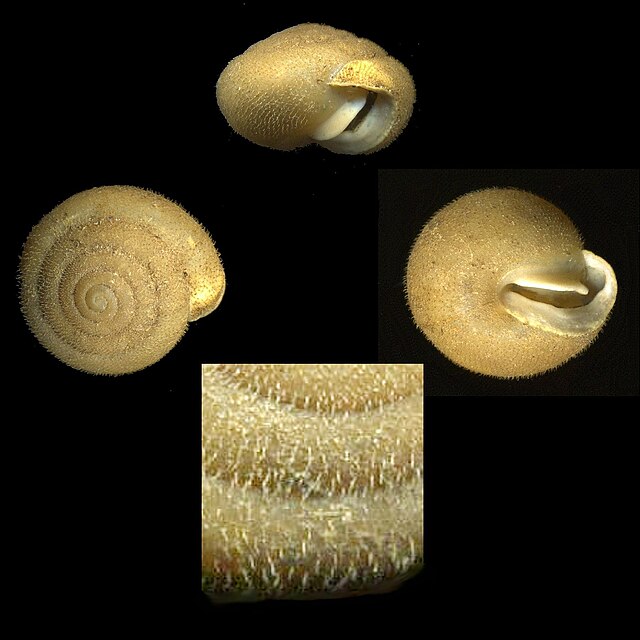外壳膜(periostracum),亦作壳皮[1]:251,是软体动物及腕足动物的外壳之外的一层包裹物;但两个分类的外壳膜由不同材质组成,亦使这两种外壳膜表现出不同的特征。在软体动物,主要为腹足纲及双壳纲最常见,但在头足纲如异鹦鹉螺属之类的物种也有外壳膜。外壳膜与其包裹的外壳及外壳上的其他分层都是整个外壳的整全部分,也成为了这些物种的可分辨外观。




Periostracum这个字由perio-(包围)和stracum两部分组成,意思就是“包围着外壳”,包围着外壳的钙质层(ostracum)[2]。
软体动物
软体动物的外壳膜是一层覆盖在新鲜壳表面的纤维状角质物[1]:251,这种角质蛋白叫作贝壳素,主要由醌鞣制的蛋白质组成,与其他生物上皮组织组成的角质层相似[3]。
The formation of a shell requires certain biological machinery. The shell is deposited within a small compartment, the extrapallial space, which is sealed from the environment by the periostracum, a leathery outer layer around the rim of the shell, where growth occurs. This caps of the extrapallial space, which is bounded on its other surfaces by the existing shell and the mantle.[4]:475 The periostracum acts as a framework from which the outer layer of carbonate can be suspended, but also, in sealing the compartment, allows the accumulation of ions in concentrations sufficient for crystallization to occur. The accumulation of ions is driven by ion pumps packed within the calcifying epithelium. The organic matrix forms the scaffold that directs crystallization, and the deposition and rate of crystals is also controlled by hormones produced by the mollusc.[4]:475 The periostracum was probably essential in allowing early molluscs to obtain large size with a single valve.[5]
The periostracum is secreted from a groove in the mantle, termed the periostracal groove. When secreted, it consists of the soluble protein periostracin; this polymer becomes insoluble through a tanning process involving quinone.[4]
Periostracum is often yellowish or brownish in color. In some species it is black. The periostracum is very often a different color than the underlying layer of the shell.
In the shells of species which have periostracum, this shell layer is quite often physically worn away or chemically eroded in the parts of the shell that are older, thus it may only still be visible in the more recently formed areas of the shell.
Periostracum can in some cases be quite thin, smooth, glossy and transparent, such that it looks almost like a thin yellow varnish, or it can be thicker and more or less opaque. When it is thick it is often relatively rough in texture and dull. In some species the periostracum is tufted, or forms hair-like growths which in some cases can give the fresh shell a velvety feel, see. In some species the periostracum adheres very tightly to the underlying shell surface, in others the periostracum is less firmly attached.
In certain marine species, such as for example certain species of cone snails, a heavy periostracum obscures the color patterns that exist on the calcareous layer of the shell.
In many aquatic species, once a shell has been removed from the water and has had time to completely dry out, then the periostracum may become brittle and start to flake or peel off of the surface of the shell.
It is not uncommon for shell collectors to deliberately remove a periostracum layer (using household bleach) if they feel that a shell is more attractive without it. However the periostracum is an important part of the shell, and is definitely of interest to malacologists. Details of the periostracum can sometimes be very helpful in identifying a species.
Haired shells occur in gastropods in several species of the Stylommatophoran families Polygyridae, Helicidae and Hygromiidae. These families are only distantly related, suggesting that this features has evolved several times independently. Haired shells are almost exclusively observed in species living in moist microhabitats, like layers of fallen leaves, broad-leaved vegetation, damp meadows or wet scree. Such a correlation suggests an adaptive significance of the trait in such a habitat; it was thus speculated that the hydrophobic hairs facilitate the movement in wet environments by relieving surface tension.[6]
These hairs can reach varying densities (up to 20 per squaremilimetre) and lengths (up to three millimetres). In some cases hardly visible, they confer an almost furry impression to the shell in others. These semi-rigid structures are part of the periostracum, a thin protein layer (conchiolin) secreted by the snail to cover the calcareous shell. Building hairs requires the snail to have specialised glandular tissue and complex strategies to form them. Consequently, this trait can be assumed to be costly and should thus present a selective advantage to its bearers in order to be conserved.[6]
Experiments by Pfenninger et al. (2005)[6] on genus Trochulus showed an increased adherence of haired shells to wet surfaces. Haired shells appeared to be the ancestral character state, a feature most probably lost three times independently. The possession of hairs facilitates the adherence of the snails to their herbaceous food plants during foraging when humidity levels are high. The absence of hairs in some Trochulus species could thus be explained as a loss of the potential adaptive function linked to habitat shifts.[6]
腕足动物
腕足动物门的外壳膜在不同物种由不同成分组成,包括有:糖胺聚糖及甲壳素、几丁质或蛋白质,当中以几丁质为主。 在这些腕足动物的外套膜边沿上相对比较新的细胞所分泌的物质将外壳膜延展,但又会被其外套膜上层较新的细胞所取代,然后转变功能成为为其外壳分泌矿物质构筑物的细胞[7]。
参看
- 外壳 (软体动物)
- Lorica
参考文献
Wikiwand in your browser!
Seamless Wikipedia browsing. On steroids.
Every time you click a link to Wikipedia, Wiktionary or Wikiquote in your browser's search results, it will show the modern Wikiwand interface.
Wikiwand extension is a five stars, simple, with minimum permission required to keep your browsing private, safe and transparent.
